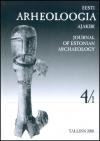BRACTEATE PENDANT FROM THE LINNAKSE HOARD: ARCHAEOMETRIC DISCUSSION OF THE SILVER ARTEFACT
BRACTEATE PENDANT FROM THE LINNAKSE HOARD: ARCHAEOMETRIC DISCUSSION OF THE SILVER ARTEFACT
Author(s): Ülle TamlaSubject(s): History, Archaeology, Local History / Microhistory
Published by: Teaduste Akadeemia Kirjastus
Summary/Abstract: The article presents the research results of a small fragment of a silver ornament from the hoard (tpq 1059), discovered in Linnakse village in northern Estonia in 2010. An archaeometric study method was applied to estimate the materials and techniques used for the production of this rare artefact and to establish the original shape, function and origin of the decoration. A scanning electron microscope supplied with an energy dispersive (EDS) X-ray micro analyzer was used for the analyses of materials. It turned out that the ornament was made from an alloy with a high content of silver at a maximum of 98.4%. The beaded wire soldered along the edge was made from a similar alloy as the ornament; the front side has traces of amalgamating gilt. The die impression decorating the ornament resembles the obverse of the coins minted during the reign of the Anglo-Saxon king Aethelred II and the imitations struck after them in Scandinavia. The only find that has several similarities with the Linnakse ornament originates from a silver hoard discovered in Kännungs (tpq 1025–1030) on Gotland in 1934 and was called by Mårten Stenberger (1947) a bracteate pendant. It is possible that the place where such types of silver ornaments were made was Gotland, which had reached an outstandingly high level in jewelry crafts.
Journal: Eesti Arheoloogia Ajakiri
- Issue Year: 20/2016
- Issue No: 2
- Page Range: 150-164
- Page Count: 15
- Language: English

